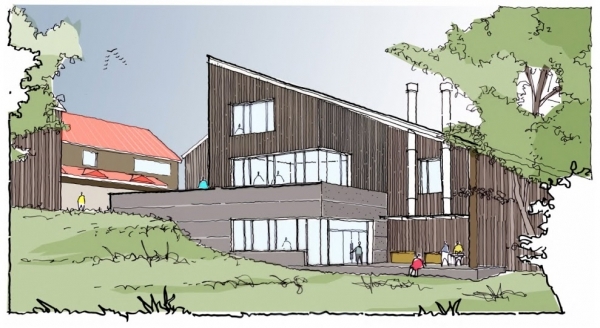MARLBORO — Marlboro College is breaking ground in early September on a new building for the arts on its undergraduate campus here.
The Snyder Center for the Visual Arts was made possible through a $2.6 million anonymous donation, part of a total $3.5 million gift. The donor is described in a press release as “a loyal, longtime supporter.”
Marlboro College said it named the center in honor of the Snyder family's long commitment to the arts at Marlboro and in southern Vermont.
The building was designed by the Gensler architectural firm, which has offices worldwide.
According to the press release, the Snyder Center for the Visual Arts, covering nearly 14,000 square feet on three floors, will be built adjacent to existing visual arts buildings and help define a small quad.
The press release adds that the center will include classrooms; a gallery space; a digital media lab; student, ceramics, and sculpture studios; and a welding area.
“The low-sloping roof of the planned building echoes the topography of the existing slope, and preserves daylight exposure for existing buildings and the quad,” the school adds.
According to Marlboro's Martina Lantin, a ceramics professor who has headed up a users' group representing faculty and students in planning with the architects, other features of the building include a dedicated film viewing space for use in the teaching of film and video studies, and integrated, two-dimensional media teaching spaces.
“It's been really rewarding working with the architects. They asked interesting questions about our curriculum and what kind of culture we want the space to generate,” Lantin said in the announcement.
The center is slated for completion in 2015, at which time the college will host a grand opening.
When a kiln shed just isn't enough
The idea for a new building came about through a conversation that Lantin had with Dan Cotter, the college's director of physical plant and operations, over renovating the school's kiln shed.
Cotter told The Commons that, as the staffer overseeing Marlboro College's facilities, he is responsible for all the physical plants and buildings and how they function.
When Lantin was hired a few years ago, “as I always do with new employees, I visited her to see how she was fitting into the existing space where she would be working,” he said.
“As we began discussing her vision, quickly it became apparent that rather than remodeling a new building, it [erecting a new one] would be the best solution for Martina and the visual arts at Marlboro.”
Lantin agreed: “We became excited about the potential a new space would offer the curricular program and the future of the arts at Marlboro.”
She said arts overall is a very strong curricular area of the college, with what she said were a quarter of the student body incorporating some aspect of the arts into their Plan of Concentration.
Both said they saw that a new building could be special for a variety of reasons. Primarily, Lantin said, it will give the visual arts at the college “an opportunity to become more fluid and unified in its teaching spaces.”
“The digital media lab will come into the new building from the library, bringing the analog and digital teaching spaces for film closer together. The building will unify sculpture and ceramics onto one level, allowing for more interaction between materials for those interested in working three-dimensionally,” she said.
The new building is planned to allow for additional, exciting opportunities for disciplines campuswide to interact with the arts program. It also will open classroom and meeting space to the community.
The new space also will expand the college's gallery capacity, ensuring exhibition space for students, and allowing greater flexibility in the programing of the existing Drury Gallery, Lantin explained.
With these goals in mind, and as with any proposed structure at Marlboro, Cotter formed a Standing Building Committee to consider all aspects of the project.
Lantin served on this committee, both as one of two faculty persons primarily using the building and in her capacity as head of the users' group, working with the architect.
Cotter said he told everyone, “Float any ideas [you] might have. Don't be frugal now. We'll consider what we can afford later, down the road.”
“I felt it imperative that no idea was ignored,” he told The Commons. “Often, when you [ignore ideas] you only end up with some regrets in the future. In the end, at least on this structure, the building determined the budget and not the other way around.”
After considering various approaches of use, the committee commissioned a design. This helped them estimate costs, and the school set to raising construction capital.
Marlboro College President Ellen McCulloch-Lovell explained at the school's website that, “We have discussed creating a more functional and aesthetically pleasing space for art students, faculty, and visiting scholars, for several years.”
Now, she said, “thanks to the generosity of our donor, this new arts center will become a hub of interdisciplinary collaboration and a bright, new space for exhibitions, workshops, and events.”
Looking ahead, Lantin said the visual arts area, and particularly material-intensive areas, will benefit from a new building “that encourages the cross-disciplinary work common at the school in a space that is welcoming, healthful, and safe for all.”
To Cotter, the facilities chief, among the building's main strengths are its energy effiency and excellent use of space. And, he said, “it provides a way to have greater collaborations between the school's disciplines.”
